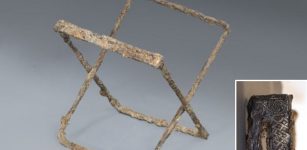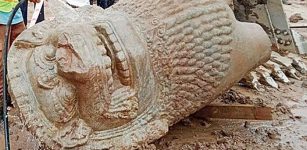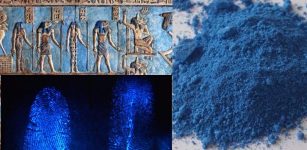Magical Cap Of Invisibility Worn By Athena, Hades, Hermes, And Perseus
Ellen Lloyd- AncientPages.com - Have you ever wanted to become invisible? You may have to wait until an invisibility cloak like Harry Potter's is available in the local store.
Meanwhile, we can always learn about ancient mythological beings who possessed the ability to become invisible at will. In ancient myths and legends, we come across several magical objects that gave a person the ability to become invisible.
Left: A helmet was worn to become invisible. Credit: Public Domain: Middle: Goddess Athena. Credit: Public Domain. Right: God Hermes. Credit: Stock Photo
One of them was the magical Ring of Gyges, which granted its owner the ability to become invisible at will.
The magical ring was perhaps a mythical object, but Gyges existed and was a historical figure, though barely anything is known about his life and reign.
The Cap Of Invisibility is mentioned in Greek mythology. It was a helmet used by the goddess Athena, the gods Hermes and Hades, and the hero Perseus whenever they wanted or needed to become invisible.
After the god Zeus liberated the Cyclops, who had been held as prisoners of Tartarus, the giants wanted to return the favor. They were undoubtedly ugly and frightening to look at, but they were skilled builders and craftsmen.
The Cyclops "went to work, beating metal on the anvil, forging for Zeus the lightning and thunderbolts of his wrath. For Poseidon, they made a huge trident, a three-pronged fork with wicked points. And for Hades, later Lord of the Underworld, they fashioned a cap of invisibility." (Michael Foss - Gods and Heroes: The Story of Greek Mythology)
Perseus Arming Himself. One of the nymphs holds out the kunea, while the others hold a winged sandal and the kibisis. Image credit: Edward Burne-Jones - 1885. Public Domain
Hades was the one who owned the Cap of Invisibility, and he used it when he fought the Titans. Hades was considered especially dangerous when he roamed the Earth wearing his helmet of invisibility.
Goddess Athena wore the Cap of Invisibility on several occasions. During the Trojan War, she had to become invisible so that Ares, the Greek god of war and one of the twelve Olympians, couldn't notice she was helping Diomedes, his enemy.
When the god Hermes was forced to fight the giant Hippolytus, whom he also killed, he wore the Cap of Invisibility.
One of the most famous mythological stories relating how practical the Cap of Invisibility was involves the hero Perseus' slaying of the Medusa monster.
Medusa's fate was sealed once Athena cursed her. As Ancient Pages wrote earlier, Perseus sought Medusa out to defeat her once and for all.
Perseus used the Cap of Invisibility to kill Medusa.
What was tragic for Medusa was that Perseus had some help from the gods. He was given special weapons to defeat her and escape her monstrous siblings. Athena gave Perseus the Cap of Invisibility. Wearing the magical helmet, Perseus could avoid the gorgon's deadly gaze and successfully escape from the immortal monsters Stheno and Euryale after he had decapitated Medusa.
The Cap of Invisibility offered complete protection, and its wearer could hide even from the eyes of supernatural beings.
This fantastic magical object is also known as the Cap of Hades, Helm of Hades, or Helm of Darkness. The ability to become invisible was mentioned in many myths and legends.
In Welsh mythology, we encounter a "Mantle of Invisibility" in the story of Culhwch and Olwen. In German mythology, a dwarf king is the owner of the Tarnkappe, enabling him to become invisible at will. Sometimes, it is said that gods possessed supernatural powers that gave them the ability to vanish into thin air. On other occasions, they used particular objects like the Cap of Invisibility so that no one could see them.
Updated on March 14, 2024
Written by Ellen Lloyd – AncientPages.com
Copyright © AncientPages.com All rights reserved. This material may not be published, broadcast, rewritten or redistributed in whole or part without the express written permission of AncientPages.com
More From Ancient Pages
-
 Extremely Rare Medieval Folding Chair Reveals Its Secrets
Archaeology | Oct 13, 2023
Extremely Rare Medieval Folding Chair Reveals Its Secrets
Archaeology | Oct 13, 2023 -
 Native American Tradition Of A Vision Quest – How To Enter The Spiritual World
Ancient Traditions And Customs | Apr 25, 2017
Native American Tradition Of A Vision Quest – How To Enter The Spiritual World
Ancient Traditions And Customs | Apr 25, 2017 -
 On This Day In History: Solar Storm Known As The Carrington Event Took Place – On August 28, 1859
News | Aug 28, 2016
On This Day In History: Solar Storm Known As The Carrington Event Took Place – On August 28, 1859
News | Aug 28, 2016 -
 3D-printed replica of an artefact revives music of Iron-Age Ireland
News | Sep 4, 2015
3D-printed replica of an artefact revives music of Iron-Age Ireland
News | Sep 4, 2015 -
 How And Why Did Ancient Egyptians Women’s Rights Change During The Greco-Roman Period?
Archaeology | Apr 16, 2019
How And Why Did Ancient Egyptians Women’s Rights Change During The Greco-Roman Period?
Archaeology | Apr 16, 2019 -
 Saturnalia Feasts In Roman Empire
Ancient History Facts | Jun 30, 2018
Saturnalia Feasts In Roman Empire
Ancient History Facts | Jun 30, 2018 -
 Gold Treasures Of Ancient King Discovered In North America Create Historical Problems
Ancient Mysteries | Jun 29, 2018
Gold Treasures Of Ancient King Discovered In North America Create Historical Problems
Ancient Mysteries | Jun 29, 2018 -
 Why Do Native Americans Often Wear Long Hair?
Ancient History Facts | Sep 19, 2019
Why Do Native Americans Often Wear Long Hair?
Ancient History Facts | Sep 19, 2019 -
 Two Pieces Of A Six-Foot-Tall Lion Statue Accidentally Found In Phnom Penh, Cambodia
Archaeology | Sep 12, 2020
Two Pieces Of A Six-Foot-Tall Lion Statue Accidentally Found In Phnom Penh, Cambodia
Archaeology | Sep 12, 2020 -
 Remarkable Marble Fragment From The Temple Of Zeus In Akragas Found Underwater Off The Coast Of Sicily
Archaeology | Feb 6, 2024
Remarkable Marble Fragment From The Temple Of Zeus In Akragas Found Underwater Off The Coast Of Sicily
Archaeology | Feb 6, 2024 -
 Master Kong Confucius: Great Philosopher And ‘Teacher Of All Teachers’ Ahead Of His Time
Featured Stories | Nov 25, 2016
Master Kong Confucius: Great Philosopher And ‘Teacher Of All Teachers’ Ahead Of His Time
Featured Stories | Nov 25, 2016 -
 Mystery Of The Horrible ‘Thing’ Found In A Dominican Monastery
Featured Stories | Sep 4, 2023
Mystery Of The Horrible ‘Thing’ Found In A Dominican Monastery
Featured Stories | Sep 4, 2023 -
 Scientists Found Mysterious Prophecies In Ancient Egyptian Pyramid – Are They Linked To The Strange Visions Some Experience Inside?
Featured Stories | Dec 17, 2024
Scientists Found Mysterious Prophecies In Ancient Egyptian Pyramid – Are They Linked To The Strange Visions Some Experience Inside?
Featured Stories | Dec 17, 2024 -
 Ancient Native Americans’ Encounter With The Star People – An Otherworldly Rescue?
Ancient Mysteries | Jul 20, 2021
Ancient Native Americans’ Encounter With The Star People – An Otherworldly Rescue?
Ancient Mysteries | Jul 20, 2021 -
 Ancient Stone Monoliths In Ethiopia Are 1,000 Years Older Than Previously Thought
Archaeology | Dec 11, 2021
Ancient Stone Monoliths In Ethiopia Are 1,000 Years Older Than Previously Thought
Archaeology | Dec 11, 2021 -
 Ancient Egyptian Blue Powder Makes Fingerprints Glow And Will Be Used By Crime Scene Investigators
Ancient Technology | Jun 15, 2017
Ancient Egyptian Blue Powder Makes Fingerprints Glow And Will Be Used By Crime Scene Investigators
Ancient Technology | Jun 15, 2017 -
 On This Day In History: Peter The Great Defeats Charles XII Of Sweden At The Battle Of Poltava – On June 28, 1709
News | Jun 28, 2016
On This Day In History: Peter The Great Defeats Charles XII Of Sweden At The Battle Of Poltava – On June 28, 1709
News | Jun 28, 2016 -
 Wasabi Plant Can Save Ancient Bio-Deteriorated Papyrus
Scripts, Paintings & Inscriptions | Apr 4, 2024
Wasabi Plant Can Save Ancient Bio-Deteriorated Papyrus
Scripts, Paintings & Inscriptions | Apr 4, 2024 -
 Huge Statue Of Pharaoh Ramesses II Unearthed In The Ancient City Of Hermopolis
Archaeology | Mar 4, 2024
Huge Statue Of Pharaoh Ramesses II Unearthed In The Ancient City Of Hermopolis
Archaeology | Mar 4, 2024 -
 Well Of Urd (Urdarbrunn): Abode Of Fate Goddesses And Powerful Symbol In Norse Beliefs
Featured Stories | Dec 17, 2022
Well Of Urd (Urdarbrunn): Abode Of Fate Goddesses And Powerful Symbol In Norse Beliefs
Featured Stories | Dec 17, 2022



